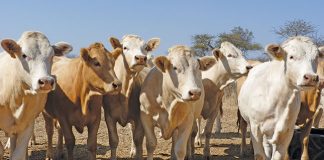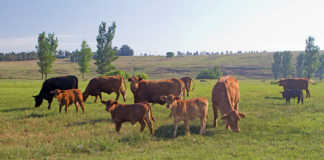Reuter Sorour has always been interested in an organic approach to agriculture, and produced his first organic crop in 1998. By 2000 his land, Emma Farms near Ficksburg, was organically certified. Two years later, wanting to diversify his organic production, Reuter contacted Woolworths about the possibility of producing and supplying organic milk to the chain store. Chris Botha of Woolworths visited him and a verbal agreement concerning a premium for organic-in-conversion milk was reached.
He was then referred to Homsek Dairy near Bloemfontein. But, once a business relationship was initiated and the process of converting to organic production started, Reuter and Andrew Tilsley (who sold his milk through Emma Farms) received a maximum premium of only about 15% over conventional milk prices in the area. “The price was not satisfactory from the start,” Reuter says, explaining that his original agreement with Woolworths had never been honoured. “Although nothing was put on paper at the meeting, Chris did say that there would be an initial 15% premium to help us through the conversion period.
But I believed the premium paid by Woolworths for organic milk would be a premium over Woolworths’ own price, and not the average conventional milk price in a particular area,” Reuter says. “My reasoning is that the retail premium Woolworths charges is a premium over their Ayrshire brand price and not some arbitrary price in the production area. I therefore believe our premium should be based on the Woolworths Ayrshire price,” he explains.
Reuter says the situation has been discussed with Anton Homsek from Homsek Dairy “for years” to no avail. According to Homsek – as made clear in numerous letters – the situation is simple. According to their calculations, a premium of 30c per litre, based on conventional milk produced in the area, is a solid premium to develop the organic milk niche market.
Reuter, however, argues that the amount is completely unreasonable considering the expensive transition and adaptation needed when changing to organic milk production. “The net result of this method of price-making is that we [organic-in-conversion producers] receive less for milk than conventional Ayrshire farmers working through other Woolworths suppliers,” Reuter says.
Organic production is expensive
“The premium is not just about more money. It is critical to make the entire operation viable,” Andrew says. He explains that significant premiums are supposed to protect organic milk producers from costs incurred while restructuring production systems to organic requirements and standards. Central to this process is ensuring that organic feed can be produced – or sourced – for the dairy herd. “Sourcing and producing organic feed [with costly organic fertiliser] can be extremely difficult and expensive,” Andrew says. Initially, even once these challenges have been met, production can drop by more than 50% compared with conventional milk production.
Neighbour Alec Botha, for example, used to milk on average 17 litres per cow per day, but within the context of the organic standard he was getting eight litres. Andrew and Reuter suffered similar drops in production. “We can’t milk eight litres a cow and not get a decent premium – it’s laughable!” Alec says. Compounding the effects of such a double-edged sword are additional costs such as improvements to dairies and evaluation by SGS, an international organic certification body based in Geneva, Switzerland, and is linked to Woolworths. By mid-2006, these farmers found it difficult to cope and continued to demand a higher premium for their in-conversion milk. They were in for a rude surprise.
Full organic or nothing
“On 10 October 2006 we were notified by letter by Homsek Dairy that Woolworths would be taking no more organic-in-conversion milk after the end of November 2006, and that a transition to full organic milk production in approximately seven weeks was needed,” Reuter told Farmer’s Weekly. This was followed by a letter on 1 November 2006, notifying them of the possible termination of milk collection. This was because other farmers that had been certified fully organic could be taken on board on a first come, first served basis. In the 10 October letter, Homsek Dairy claimed that Woolworths had forced the decision based on the fact that in-conversion status for dairy products should last no more than 90 days, and would soon cease printing in-conversion labelling for Homsek Dairy. Why and how SGS had certified these Ficksburg farmers as “in conversion” for over two years is understandably mystifying to them.
This is especially true for Reuter, whose farms were the first in the area to be fully organically certified and whose cows were “eligible for full organic status, other than [being fed] purchased conventional concentrates” in 2003. Homsek Dairy’s letter, however, argues that drops in Reuter’s production were a key issue, as other farmers also had to be considered.
Reuter has another interpretation. “Although our volume dropped significantly, this was well after new producers were approached by Anton [Homsek] to go into the conversion process,” Reuter says. “One of the reasons for the reduction in volume was that we stopped feeding most conventional feeds [concentrates] way before it was necessary in terms of our certification, as we would not have had access to them once we were fully organic. This, together with reduced prices, led to financial pressure, a less than ideal feed situation and consequent low production. At this time we also sold some cows, which should have been replaced but weren’t.”
However, most shocking to Reuter is that the very demand for transition from “in-conversion” to full organic in about seven weeks is technically in contravention of the organic standard. “The standard states that full organic feed requirements need to be implemented at least 12 weeks before selling organic products,” Reuter says.
In the end, he became concerned about the integrity of the entire process. In November 2006, he wrote a letter to Woolworths explaining his view. “My concern and reason for this letter are that commercial decisions seem to be clouding organic integrity,” he wrote. The letter elicited no reaction.
Side-stepping the standard?
“The issue of non-compliance with organic standards needs to be addressed. For a producer still feeding conventional concentrates and getting the organic premium, business must be very good. It is the possibility of such supply that makes us dispensable,” Reuter says, adding that it’s possible to bend the rules, particularly when tempted to do this by the insufficient payment for milk produced. “It is quite easy to produce milk organically very close to conventional systems. All you have to do is be prepared to justify your actions and look for the loopholes in the standard,” he says.
To give one example: the standard stipulates that cattle should have access to pasture, but does not say for how long. “It [the organic standard] doesn’t stipulate for how long or how many days per week or hours per day this access should be.
Therefore, if your cows have access to pasture for two weeks after good rains, this counts as ‘access’. That’s not the perception the organic consumer has of organic milk,” Reuter says.
Alec and Andrew agree. “To cut corners is absolutely possible,” Alec says, and adds, “The situation is not properly policed by SGS.” The men argue that evaluations are based on nothing more than a day’s visit and a year’s paperwork by farmers, giving individuals the opportunity to cover up undesirable discrepancies. To Alec and Andrew, all such arguments and speculations are now (sadly) immaterial, as they didn’t make the conversion deadline to full organic – a deadline that they believe they did not have to make in the first place, according to the standard. Alec is relieved that he no longer has to deal with the complexities of organic farming. “There are no sour grapes. I am happy I don’t produce for Woolworths any more, but I think producers should be warned about what they could be getting themselves into,” he says.
For Andrew, the bottom line was economic. “It’s about survival; I have gone back to conventional milk production as I was simply making too little money,” he says.
Reuter is more fortunate: he made the deadline and is still involved with Homsek Dairy and Woolworths. “We fed some conventional maize silage during winter, and were just lucky that it fell within the maximum allowable daily intake of 25%
and annual limit of 5%, which was because of our organically certified land. Everything else was already in place for full organic status,” he says. His disillusionment, however, continues.













